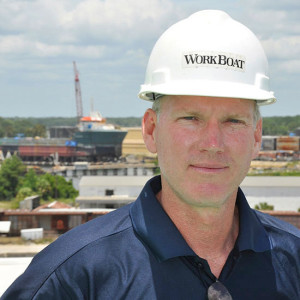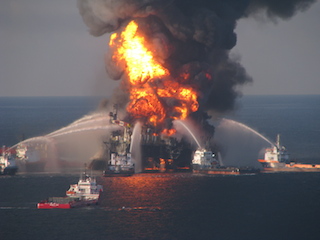The five-year anniversary of the Deepwater Horizon disaster brought memorials for the 11 men who died, new scientific findings and government proposals for better blowout prevention.
The anniversary happened against the backdrop of renewed publicity campaigns from BP, and from opponents of opening new offshore leases in the mid-Atlantic and Arctic.
“The Deepwater Horizon oil spill in the Gulf caused unprecedented environmental and economic damage and proved that the technology does not exist to prevent offshore oil spills,” said Rep. Frank Pallone, D-N.J., who is one of a Congressional bloc from Northeast states looking to prevent federal offshore energy leases off the Virginia coast.
Pallone and Sen. Robert Menendez, D-N.J., said Monday that they would introduce legislation, the Clean Ocean and Safe Tourism (COAST) Anti-Drilling Act, to prohibit the Department of the Interior from issuing any leases in Atlantic coast planning areas. Under the rules now, seismic exploration could start this year and drilling by 2021. Any attempt to ban that on the East Coast is unlikely to get much support in the Republican-dominated House of Representatives. But Pallone said he’s managed to get 13 co-sponsors in the House, and Menendez has seven in the Senate.
With $37.5 billion committed to cleanup and settlement costs, and under the gun for a potential $13.7 billion in court-ordered Clean Water Act damages, BP stepped up its public relations effort in the month leading up to the anniversary. An environmental report, along with the company’s print and television advertising and social media, carry the message that the Gulf of Mexico ecosystem “is returning to its baseline conditions.”
Other scientists say it’s still too early to make that claim.
Samantha Joye of the University of Georgia has led a team since 2010 studying the fate of the estimated 3 million bbls. of crude oil that gushed into the Gulf of Mexico for 87 days. On a return trip in 2014, Joye took a dive in the research submersible Alvin to check out deep-sea floor conditions.
Joye and her team had documented just how much native Gulf bacteria had mitigated the spill by digesting a significant portion of the light crude. But the fallout from that pig-out – sheets of decayed organic matter on the bottom – smothered benthic organisms and could change the deep sea ecosystem in ways unknown.
BP’s reports on the other hand stress findings of low oil contamination in sediment samples.
“Fewer than 2% of the more than 8,000 sediment samples collected exceeded the EPA sediment toxicity benchmark for aquatic life, and these were largely limited to the area close to the wellhead,” the company reported in its March summary.
Last week the Interior Department released its proposals for enhancing the reliability of blowout preventers and other offshore safety measures, having boiled down some 370 specific recommendations from the U.S. Coast Guard, government oversight boards, industry and other sources.
“The blowout preventer, an essential piece of safety equipment used in offshore drilling operations, was a point of failure in the Deepwater Horizon event, but several other barriers failed as well,” Interior officials said in an April 13 statement. “The cascade of multiple failures resulted in the loss of well control, an explosion, fire and subsequent months-long spill.”
“We worked to collect the best ideas on the prevention of well control incidents and blowouts to develop this proposed rule – including knowledge and skillsets from industry and equipment managers,” said Assistant Secretary for Land and Minerals Management Janice Schneider.
“In addition to more stringent design requirements, the proposed rule requires improved controls of all repair and maintenance activities through the lifecycle of the blowout preventer and other well control equipment,” said Brian Salerno, director of the Interior Department's Bureau of Safety and Environmental Enforcement. “It would provide verification of the performance of equipment designs through third party verification, enhanced oversight of operations through real-time monitoring viewed onshore, and require operators to, during operations, utilize recognized engineering best standards that reduce risk.”
Sen. David Vitter, R-La., marked the anniversary with a statement listing “lessons learned” in the aftermath of Deepwater Horizon. While acknowledging the human and ecological damages, Vitter’s list is notable for its criticism of the Obama administration’s early response of curtailing offshore permits.
“The lives and safety of the men and women who work in this field are paramount, and the safety standards overseeing them should reflect that as a priority,” Vitter said as a preamble, adding that federal agencies must “enforce strong, necessary safety and environmental standards.”
However, Vitter said, “we cannot allow the administration to have a knee-jerk reaction, like the offshore drilling moratorium that shut down all offshore drilling, and therefore crippled the Louisiana economy.”
For accidents of such scale, “there needs to be a specific judicial and penalization process in place” to ensure that claims for damages “can be efficiently filed and finalized,” Vitter said, referring to the prolonged disputations between BP, the federal special master for claims Kenneth Feinberg and other parties.
In all, Vitter concluded, “Louisiana is the most resilient state in the nation and can bounce back from devastating tragedies.”
Exactly how high that bounce has been is subject to much debate. In May 2014 the Louisiana Department of Wildlife and Fisheries got in a public tiff with BP by declaring shrimp from some closed inshore areas to be a “public health risk” when landed by illegal fishing. BP reacted strongly, insisting that about 10,000 seafood samples it paid to test had not shown any contamination levels over the U.S. Food and Drug Administration’s standards.
By aggregate numbers, Louisiana’s commercial seafood landings have grown since 2010 when 793 million lbs. were worth $233 million. Landings went to 1.3 billion lbs. in 2011, dipped to 849 million lbs. in 2012, and were back over 1 billion lbs. worth $399 million in 2013, according to National Oceanic and Atmospheric Administration statistics.
But those fortunes are widely scattered. Oystermen, especially those on the east bank of the Mississippi, say they are still waiting for a rebound.




